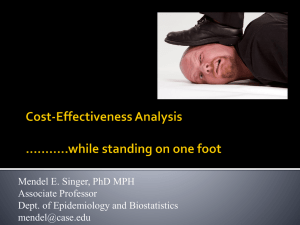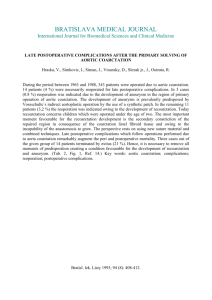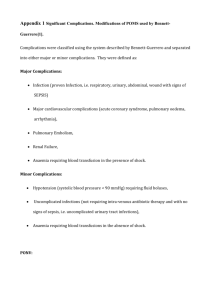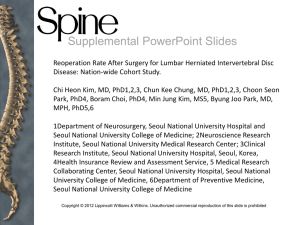Cervical Disc Disease Cost-Effectiveness Analysis Appendix
advertisement
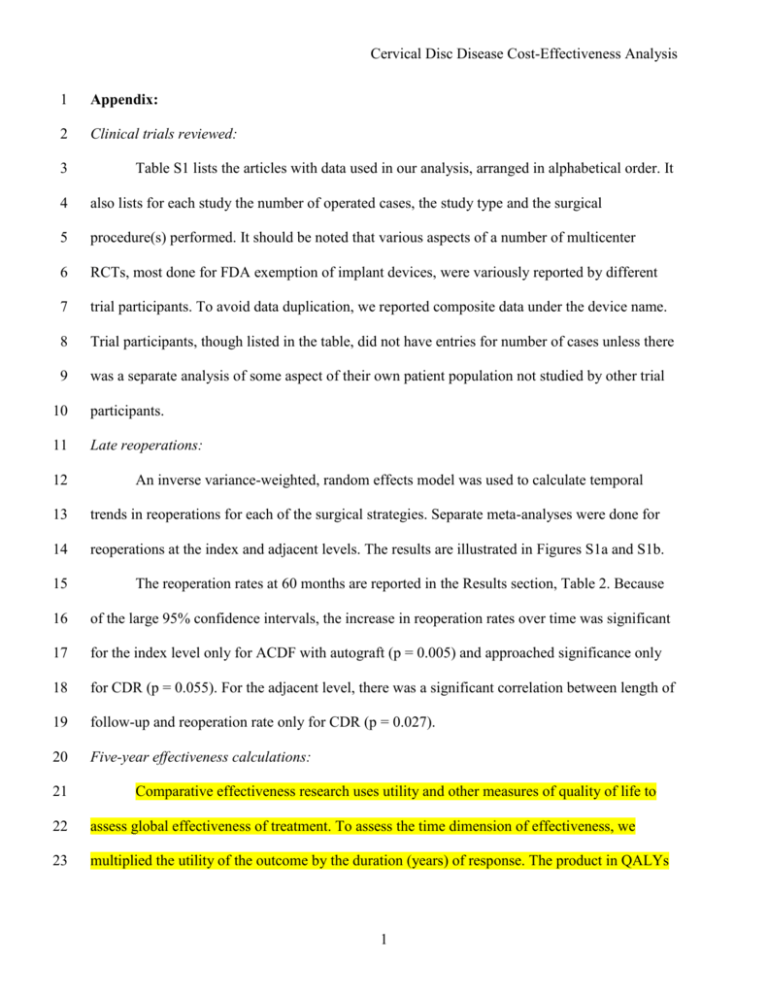
Cervical Disc Disease Cost-Effectiveness Analysis 1 Appendix: 2 Clinical trials reviewed: 3 Table S1 lists the articles with data used in our analysis, arranged in alphabetical order. It 4 also lists for each study the number of operated cases, the study type and the surgical 5 procedure(s) performed. It should be noted that various aspects of a number of multicenter 6 RCTs, most done for FDA exemption of implant devices, were variously reported by different 7 trial participants. To avoid data duplication, we reported composite data under the device name. 8 Trial participants, though listed in the table, did not have entries for number of cases unless there 9 was a separate analysis of some aspect of their own patient population not studied by other trial 10 participants. 11 Late reoperations: 12 An inverse variance-weighted, random effects model was used to calculate temporal 13 trends in reoperations for each of the surgical strategies. Separate meta-analyses were done for 14 reoperations at the index and adjacent levels. The results are illustrated in Figures S1a and S1b. 15 The reoperation rates at 60 months are reported in the Results section, Table 2. Because 16 of the large 95% confidence intervals, the increase in reoperation rates over time was significant 17 for the index level only for ACDF with autograft (p = 0.005) and approached significance only 18 for CDR (p = 0.055). For the adjacent level, there was a significant correlation between length of 19 follow-up and reoperation rate only for CDR (p = 0.027). 20 Five-year effectiveness calculations: 21 Comparative effectiveness research uses utility and other measures of quality of life to 22 assess global effectiveness of treatment. To assess the time dimension of effectiveness, we 23 multiplied the utility of the outcome by the duration (years) of response. The product in QALYs 1 Cervical Disc Disease Cost-Effectiveness Analysis 24 is the standard indicator of effectiveness used in most cost-effectiveness studies. For example, a 25 patient whose fusion failure requires reoperation after three years of follow-up accrues fewer 26 QALYs than one who goes 10 years before reoperation21. We used the relative number of 27 QALYs as our measure of effectiveness. Standard scales of disability or pain such as JOA, NDI, 28 ODI and VAS or time to reoperation are valuable indicators of success but are not useful in cost- 29 effectiveness studies because they only measure one aspect of surgical outcome. 30 Ideally, we would calculate QALYs by comparing changes in utility from preoperatively 31 to various times following surgery. Unfortunately, none of the publications on the subject 32 addressed serial utilities changes. Instead of looking for changes in overall utility, our model 33 assumed that successful surgery results in a utility score of 1. Complications and surgical failures 34 at the index and adjacent levels were used to calculate the effects of adverse outcomes on utility. 35 The resulting QALY scores represent a valid comparison of operative approaches. 36 Since the utility of an operation without any adverse events (perioperative complications 37 or reoperations) equals 1, these cases would be assigned a maximum value of five QALYs over 38 the five years of follow-up. Cases who suffered perioperative complications but underwent no 39 reoperation would be assigned five QALYs multiplied by the utility associated with the 40 complications of their particular procedures (see Table 2). We assumed that reoperations were 41 performed midway during follow-up. Such cases would have their initial postoperative utilities 42 for 2.5 years and their new utilities following reoperation for the remaining 2.5 years. For 43 example, a patient undergoing CDR and experiencing perioperative complications would have a 44 utility of 0.842 (± 0.043) and thus 2.5 * 0.842 or 2.105 QALYs after 2.5 years. If this patient 45 required reoperation and there were no perioperative complications with the second procedure, 46 the new utility would be 0.915 (see Table 2, reoperation) * 0.842 (original utility), or 0.770. For 2 Cervical Disc Disease Cost-Effectiveness Analysis 47 the remaining 2.5 years in follow-up, the utility would be 1.926 QALYs. Thus, the five-year 48 utility for this case would be 2.105 + 1.926 or 4.031 QALYs. 49 Cost calculations: 50 51 52 53 Base costs are shown in Table 3 of the main manuscript. The following formulas were used to calculate costs: 1. Surgeon-related: Medicare reimbursement for primary procedure + 0.5 * sum of component procedures 54 2. Hospital-related: DRG reimbursement for facility, adjusted for complications. 55 3. Implant-related: hospital costs for devices, constructs and allograft bone where 56 appropriate. 57 4. Outpatient-related: cost of one year of follow-up, adjusted for complications. 58 Hence, costs for the first procedure equaled the sums of each cost component above, 59 adjusted for the individual procedure and whether or not complications occurred. Costs for same- 60 level reoperations were calculated with procedure-specific surgeon-related values, whereas 61 adjacent-level surgeries were calculated the same, as were initial surgeries. Table S2 reports 62 costs for each outcome category. 63 We assumed that 90% of ACDF procedures employed internal fixation, follow-up costs 64 were limited to one year, hospital-related costs for reoperation were the same as for the initial 65 procedure and reoperations for failed CDR were evenly divided between replacement and 66 revision. We further assumed that no perioperative complications were considered severe for 67 DRG purposes and that all adjacent-level surgeries employed ACDF with allograft. Lastly, we 68 assumed all delayed surgeries involved one year of outpatient follow-up. 3
